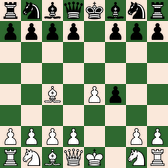We might agree that …Qd8-h4+ — the first obstacle on the way to White’s positional goals — is a high hurdle: Meeting the check by interposition (3. Qf3, 3. Nh3) or flight (3. Bc4, 3. Nc3, 3. d4, oddballs) has definite disadvantages (leaving White the plan to capture the checking piece rather than interposing or fleeing).
The Bishop’s Gambit is White’s best shot at a compromise between sharp provocation and relative king safety, but it can be difficult to develop the king rook.
Unlike 4. Ke2 and 4. Kd2, 4. Kf1 preserves the mobility for queen and bishop, while f1 is a safe flight square compared to e2 and d2. The king rook can be shut out, though.
For displaying the h1-rook’s frustration in the Bishop’s Gambit, Riemann-Anderssen is like a 30-second commercial, whereas Hromadka-Spielmann is like a movie.
Source image for thumbnails.
